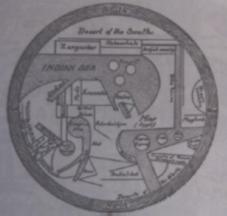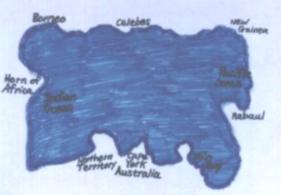Pyramids In The Pacific

The Unwritten History Of Australia
Chapter 18
|
World-travelling Arabs and the Lands of the Gods |
"To Allah belongeth the east and the west;
therefore, whithersoever ye turn yourselves
to pray, there is the face of Allah; for Allah is
omnipresent and omniscient."
Second Sura of the Koran
Mohammed, 570?-632 AD
|
Chapter
18 Images
|

|
Istakhari World Map
From the dawn of recorded history until the beginning of the Ottoman Empire's decline in the 17th century, the Middle-east played a leading role in the spread of civilisation. Agriculture was introduced, there in Palestine and Turkey about 7000 BC and organised societies arose before 4000 BC, followed by the spread of Metallurgy, and the appearance of bronze among the peoples of upper Syria came around 3000 BC.
Iron was introduced by the Hittites in Anatolia around 1300 BC... Architecture rose to great heights in Egypt, and the goldsmiths, glass makers, and sculptors of Assyria, Egypt and Sumer created works of great beauty. These arts continued among the later Hellenistic Greeks, Byzantines and Arabs.
As early as the 3rd millennium BC, the Egyptians voyaged down the Red Sea to obtain spices and incense, and during the 2nd millennium BC, they competed with the Assyrians for the control of the trade routes leading from Arabia. The Arabs were a branch of the Semetic peoples who migrated from out of Arabia's northern borderlands, northwards in to the region between Syria and Mesopotamia, and south to the fertile south-western corner of thee peninsula.
Before his death in 323 BC, Alexander the Great sought to conquer Arabia, and also look upon the Indian Ocean, the southern boundary of his empire. He dispatched several naval expeditions to explore the entire coast of the Arabian peninsula, from the head of the Persian Gulf to the head of the Persian Gulf, to the head of the Red Sea.
He had dispatched vessels on preliminary reconnaissance of the western shore of the Persian Gulf, and his admiral, Nearcgus, had followed its eastern, {Persian} shore barely catching sight of its Arabian counterpart, as he penetrated the the narrows of th Straits of Ormuz. However, when Alexander died in Babylon all plans for further explorations were abandoned.
The Ptolomies attempted the same project a century alter, hoping to cut off the incense trade between Syria and the Selucid Empire. However, they were opposed by another Arabic nation, the Nabataeans, from northern Arabia, who in the 4th century BC, had established their capital at Petra, one of the most important caravan depots on the trade route to Syria, and would hold the balance of power between the Ptolomies and Selucids for two centuries.
In the second half of the 1st Millennium BC, in south-western Arabia, there arose the Himyarite-Sabaean civilisation, which was founded upon trade and agriculture. The Sabaeans concentrated upon the spice trade between India and the Mediterranean, by which means goods also reached here from other Asian lands.
The Himyarites cultivated frankincense along the southern coast of Arabia, where there arose a succession of Arab kingdoms from the beginning of the 5th century BC, which included Saba {biblical Sheba}, Ma'in, Qataban, Hadhramaut and Himyar. Of these the Sabaeans became the most powerful for their merchants and explorers came to dominate the sea trade in spices, silks, pearls, ivory gold, incense and slaves between the Mediterranean and Africa, India and Arabia.
It was the wealth of Saba that encouraged the Romans to conquer the kingdom in 24 BC. They were defeated by both the climate and the terrain and forced to retreat to Egypt. Not until the 3rd century AD, did Rome succeed, its armies penetrated the Red Sea, forcing the Selucids and Parthians to alter the spice route from western Arabia to the Persian Gulf and Mesopotamia.
The Abyssinians invaded Arabia in the early 6th century Ad, but were driven out by the Sassanians of Persia. They in turn occupied much of eastern Arabia in the next century. Christianity appeared here in the 1st century AD, to be replaced by Islam in the 7th; under whose direction the Arabs would be sent forth to conquer lands beyond their own. Under the Caliphs Omar and Othman they defeated both the Sassanian and Byzantine armies until they were checked at the Taurus Mountains in modern Turkey.
The Arabs absorbed Syria, Mesopotamia and Egypt {in 640 AD}into their empire. During the Umayyad caliphate, which lasted from 661 to 750 AD, the Arab Empire reached its greatest heights of conquest. They over-ran Persia and Afghanistan, the India in the east, and in the west added North Africa and most of Spain to thier rule.

|
Khwarizmi Map 820 A.D.